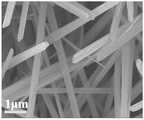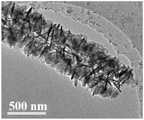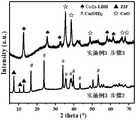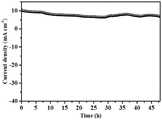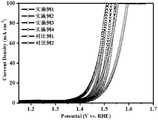CN112951623B - Copper-cobalt-zinc composite self-supporting nano array electrode material and preparation method and application thereof - Google Patents
Copper-cobalt-zinc composite self-supporting nano array electrode material and preparation method and application thereofDownload PDFInfo
- Publication number
- CN112951623B CN112951623BCN202110119660.1ACN202110119660ACN112951623BCN 112951623 BCN112951623 BCN 112951623BCN 202110119660 ACN202110119660 ACN 202110119660ACN 112951623 BCN112951623 BCN 112951623B
- Authority
- CN
- China
- Prior art keywords
- copper
- electrode material
- ions
- cobalt
- zinc composite
- Prior art date
- Legal status (The legal status is an assumption and is not a legal conclusion. Google has not performed a legal analysis and makes no representation as to the accuracy of the status listed.)
- Active
Links
Images
Classifications
- H—ELECTRICITY
- H01—ELECTRIC ELEMENTS
- H01G—CAPACITORS; CAPACITORS, RECTIFIERS, DETECTORS, SWITCHING DEVICES, LIGHT-SENSITIVE OR TEMPERATURE-SENSITIVE DEVICES OF THE ELECTROLYTIC TYPE
- H01G11/00—Hybrid capacitors, i.e. capacitors having different positive and negative electrodes; Electric double-layer [EDL] capacitors; Processes for the manufacture thereof or of parts thereof
- H01G11/22—Electrodes
- H01G11/30—Electrodes characterised by their material
- H01G11/32—Carbon-based
- H01G11/36—Nanostructures, e.g. nanofibres, nanotubes or fullerenes
- B—PERFORMING OPERATIONS; TRANSPORTING
- B82—NANOTECHNOLOGY
- B82Y—SPECIFIC USES OR APPLICATIONS OF NANOSTRUCTURES; MEASUREMENT OR ANALYSIS OF NANOSTRUCTURES; MANUFACTURE OR TREATMENT OF NANOSTRUCTURES
- B82Y30/00—Nanotechnology for materials or surface science, e.g. nanocomposites
- B—PERFORMING OPERATIONS; TRANSPORTING
- B82—NANOTECHNOLOGY
- B82Y—SPECIFIC USES OR APPLICATIONS OF NANOSTRUCTURES; MEASUREMENT OR ANALYSIS OF NANOSTRUCTURES; MANUFACTURE OR TREATMENT OF NANOSTRUCTURES
- B82Y40/00—Manufacture or treatment of nanostructures
- H—ELECTRICITY
- H01—ELECTRIC ELEMENTS
- H01G—CAPACITORS; CAPACITORS, RECTIFIERS, DETECTORS, SWITCHING DEVICES, LIGHT-SENSITIVE OR TEMPERATURE-SENSITIVE DEVICES OF THE ELECTROLYTIC TYPE
- H01G11/00—Hybrid capacitors, i.e. capacitors having different positive and negative electrodes; Electric double-layer [EDL] capacitors; Processes for the manufacture thereof or of parts thereof
- H01G11/84—Processes for the manufacture of hybrid or EDL capacitors, or components thereof
- H01G11/86—Processes for the manufacture of hybrid or EDL capacitors, or components thereof specially adapted for electrodes
- Y—GENERAL TAGGING OF NEW TECHNOLOGICAL DEVELOPMENTS; GENERAL TAGGING OF CROSS-SECTIONAL TECHNOLOGIES SPANNING OVER SEVERAL SECTIONS OF THE IPC; TECHNICAL SUBJECTS COVERED BY FORMER USPC CROSS-REFERENCE ART COLLECTIONS [XRACs] AND DIGESTS
- Y02—TECHNOLOGIES OR APPLICATIONS FOR MITIGATION OR ADAPTATION AGAINST CLIMATE CHANGE
- Y02P—CLIMATE CHANGE MITIGATION TECHNOLOGIES IN THE PRODUCTION OR PROCESSING OF GOODS
- Y02P20/00—Technologies relating to chemical industry
- Y02P20/10—Process efficiency
- Y02P20/133—Renewable energy sources, e.g. sunlight
Landscapes
- Engineering & Computer Science (AREA)
- Chemical & Material Sciences (AREA)
- Nanotechnology (AREA)
- Power Engineering (AREA)
- Crystallography & Structural Chemistry (AREA)
- Manufacturing & Machinery (AREA)
- Materials Engineering (AREA)
- General Physics & Mathematics (AREA)
- Condensed Matter Physics & Semiconductors (AREA)
- Physics & Mathematics (AREA)
- Microelectronics & Electronic Packaging (AREA)
- Composite Materials (AREA)
- Electrodes For Compound Or Non-Metal Manufacture (AREA)
- Catalysts (AREA)
Abstract
Description
Translated fromChinese技术领域technical field
本发明属于电催化全解水产氢领域,具体是一种铜钴锌复合自支撑纳米阵列电极材料及其制备方法和应用。The invention belongs to the field of electrocatalytic total hydrolysis of water for hydrogen production, in particular to a copper-cobalt-zinc composite self-supporting nano-array electrode material and a preparation method and application thereof.
背景技术Background technique
近年来,氢能因其非凡的能量密度、可持续性和零排放被视为最有前途的替代传统化石能源的可再生能源之一,引起了人们越来越多的关注。因此,开发高效生产纯氢气的途径变得十分必要和紧迫。电解水是解决此要求的一种理想选择,它是将纯水通过电化学的方法分解转化为用于储能的氢,包括阳极氧气逸出反应(OER)和阴极氢气逸出反应(HER)。然而,这两个反应都存在固有能垒和电子转移缓慢的问题。In recent years, hydrogen energy has attracted increasing attention as one of the most promising renewable energy alternatives to traditional fossil energy due to its extraordinary energy density, sustainability, and zero emissions. Therefore, it becomes necessary and urgent to develop ways to efficiently produce pure hydrogen. Water electrolysis is an ideal solution to this requirement, which is the electrochemical decomposition of pure water into hydrogen for energy storage, including anodic oxygen evolution reaction (OER) and cathodic hydrogen evolution reaction (HER) . However, both reactions suffer from inherent energy barriers and slow electron transfer.
电解水的电催化剂中,主要是用于催化OER反应的Ir/Ru基和用于催化HER的Pt基商业贵金属催化剂,但是这些贵金属催化剂的昂贵成本和有限的储量严重阻碍了大规模应用。此外,粉末电催化剂通常使用聚合物粘合剂固定活性物质以制备电极,而聚合物粘合剂不仅会阻塞活性位点,而且还会增加界面电阻。文献《Z.Chen,Y.Ha,H.Jia,X.Yan,M.Chen,M.Liu,R.Wu,Oriented Transformation of Co-LDH into 2D/3D ZIF-67to Achieve Co-N-C Hybrids for Efficient Overall Water Splitting,Adv.Energy Mater.9(2019)1803918》中利用Co氢氧化物在碳纤维上自支撑合成了高效电解水催化剂,但碳纤维作为自支撑体不可避免会遇到前期处理复杂,稳定性差等问题。因此,设计高活性和高稳定性的新型非贵金属自支撑电极材料成为实现高效电解水的重要途径。Among the electrocatalysts for water electrolysis, Ir/Ru-based catalysts for OER and Pt-based commercial precious metal catalysts for HER are mainly used, but the high cost and limited reserves of these precious metal catalysts seriously hinder their large-scale applications. In addition, powder electrocatalysts usually use polymer binders to immobilize active species to prepare electrodes, which not only block active sites but also increase interfacial resistance. Document "Z.Chen,Y.Ha,H.Jia,X.Yan,M.Chen,M.Liu,R.Wu,Oriented Transformation of Co-LDH into 2D/3D ZIF-67to Achieve Co-N-C Hybrids for Efficient Overall Water Splitting, Adv. Energy Mater. 9 (2019) 1803918" uses Co hydroxide to self-support on carbon fiber to synthesize a high-efficiency water electrolysis catalyst, but carbon fiber as a self-supporting body inevitably encounters complicated pretreatment and poor stability. And other issues. Therefore, designing novel non-noble metal self-supporting electrode materials with high activity and high stability has become an important way to achieve high-efficiency water electrolysis.
发明内容SUMMARY OF THE INVENTION
针对现有技术的不足,本发明拟解决的技术问题是,提供一种铜钴锌复合自支撑纳米阵列电极材料及其制备方法和应用。In view of the deficiencies of the prior art, the technical problem to be solved by the present invention is to provide a copper-cobalt-zinc composite self-supporting nano-array electrode material and a preparation method and application thereof.
本发明解决所述方法技术问题的技术方案是,提供一种铜钴锌复合自支撑纳米阵列电极材料的制备方法,其特征在于,该方法包括以下步骤:The technical solution of the present invention to solve the technical problem of the method is to provide a method for preparing a copper-cobalt-zinc composite self-supporting nano-array electrode material, characterized in that the method comprises the following steps:
步骤1、将铜氧化为氢氧化铜,然后洗涤、干燥后,得到氢氧化铜纳米线状阵列结构;Step 1, oxidizing copper to copper hydroxide, then washing and drying to obtain a copper hydroxide nanowire array structure;
步骤2、将步骤1得到的产物浸泡在含金属离子的甲醇溶液中,使得步骤1的产物与金属离子充分接触,金属离子充分生长于步骤1的产物上;再置于2-甲基咪唑的甲醇溶液中至固体物质由蓝色变为紫色,然后洗涤、干燥后,得到氢氧化铜自支撑纳米线状阵列结构@ZIF;所述金属离子为Co离子和Zn离子;
步骤3、将步骤2得到的产物置于含Co离子和Zn离子的乙醇溶液中,在密闭环境中进行溶剂热反应至固体物质由紫色变为灰色,得到铜钴锌复合自支撑纳米阵列电极材料。
本发明解决所述电极材料技术问题的技术方案是,提供一种所述的铜钴锌复合自支撑纳米阵列电极材料的制备方法得到的铜钴锌复合自支撑纳米阵列电极材料。The technical solution of the present invention to solve the technical problem of the electrode material is to provide a copper-cobalt-zinc composite self-supporting nano-array electrode material obtained by the preparation method of the copper-cobalt-zinc composite self-supporting nano-array electrode material.
本发明解决所述应用技术问题的技术方案是,提供一种所述的铜钴锌复合自支撑纳米阵列电极材料在电解水中的应用,其特征在于,将所述电极材料作为正极和负极,与碱性电解液组装成电解水装置。The technical solution of the present invention to solve the technical problem of application is to provide an application of the copper-cobalt-zinc composite self-supporting nano-array electrode material in electrolyzed water, characterized in that the electrode material is used as a positive electrode and a negative electrode, and the electrode material is used as a positive electrode and a negative electrode. The alkaline electrolyte is assembled into an electrolyzed water device.
与现有技术相比,本发明有益效果在于:Compared with the prior art, the beneficial effects of the present invention are:
(1)本方法利用氧化还原反应将泡沫铜氧化为氢氧化铜纳米线状阵列结构作为自支撑体操作简单易行且稳定性高,替代了传统通过聚合物粘合剂固定活性物质来制备电极的方法,降低界面电阻,提高电催化活性。(1) This method utilizes redox reaction to oxidize copper foam into copper hydroxide nanowire array structure as a self-supporting body, which is easy to operate and has high stability, replacing the traditional preparation of electrodes by fixing active substances with polymer binders method to reduce the interfacial resistance and improve the electrocatalytic activity.
(2)所得到的线状阵列结构与ZIF原位复合,通过晶型转化得到铜钴锌复合自支撑纳米阵列电极材料,其具有高度有序的空心纳米阵列,大量缺陷孔存在于纳米阵列表面,为催化过程提供了更多的活性位点和通畅的电子传输通道,有利于电解质的渗透和气体释放,体系间Cu、Co、Zn和O之间的协同作用,有利于提高材料的电化学反应活性。(2) The obtained linear array structure is in-situ composited with ZIF, and the copper-cobalt-zinc composite self-supporting nano-array electrode material is obtained through crystal transformation, which has a highly ordered hollow nano-array, and a large number of defect holes exist on the surface of the nano-array , provides more active sites and unobstructed electron transport channels for the catalytic process, which is beneficial to the penetration of electrolyte and gas release, and the synergistic effect between Cu, Co, Zn and O between systems is beneficial to improve the electrochemical performance of the material. reactivity.
(3)本发明选用非贵金属,成本低廉,反应迅速且绿色环保,可以大批量制备,具有产业化潜力。(3) The present invention selects non-precious metals, has low cost, rapid reaction and environmental protection, can be prepared in large quantities, and has industrialization potential.
附图说明Description of drawings
图1为本发明的实施例1中步骤1制备的产物的SEM图;Fig. 1 is the SEM image of the product prepared in step 1 in Example 1 of the present invention;
图2为本发明的实施例3中步骤2制备的产物的SEM图;Fig. 2 is the SEM image of the product prepared in
图3为本发明的实施例3中制备的电极材料的SEM图;3 is a SEM image of the electrode material prepared in Example 3 of the present invention;
图4为本发明的实施例3中制备的电极材料的TEM图;4 is a TEM image of the electrode material prepared in Example 3 of the present invention;
图5为本发明的实施例3中步骤2和步骤3制备的产物的XRD图;Fig. 5 is the XRD pattern of the product prepared in
图6为本发明的实施例3中制备的电极材料的XPS图;6 is an XPS diagram of the electrode material prepared in Example 3 of the present invention;
图7为本发明的实施例3中制备的电极材料的电解水LSV曲线图;Fig. 7 is the electrolyzed water LSV curve diagram of the electrode material prepared in the
图8为本发明的实施例3中制备的电极材料稳定性测试曲线图;Fig. 8 is the electrode material stability test curve diagram prepared in Example 3 of the present invention;
图9为本发明的实施例3中制备的电极材料产出H2和O2的体积变化曲线图;9 is a graph showing the volume change of H2 and O2 produced by the electrode material prepared in Example 3 of the present invention;
图10为本发明的实施例1-4及对比例1-2制备的电极材料的SEM图;其中(a)-(d)分别对应实施例1-4,(e)和(f)分别对应对比例1和对比例2;Fig. 10 is the SEM images of the electrode materials prepared in Examples 1-4 and Comparative Examples 1-2 of the present invention; wherein (a)-(d) correspond to Examples 1-4 respectively, and (e) and (f) correspond to Response to case 1 and
图11为本发明的实施例1-4及对比例1-2制备的电极材料的OER性能曲线图。FIG. 11 is a graph showing the OER performance of the electrode materials prepared in Examples 1-4 and Comparative Examples 1-2 of the present invention.
具体实施方式Detailed ways
下面结合实施例及附图对本发明作进一步说明。具体实施例仅用于进一步详细说明本发明,不限制本申请权利要求的保护范围。The present invention will be further described below with reference to the embodiments and the accompanying drawings. The specific embodiments are only used to further illustrate the present invention in detail, and do not limit the protection scope of the claims of the present application.
本发明提供了一种铜钴锌复合自支撑纳米阵列电极材料的制备方法(简称方法),其特征在于,该方法包括以下步骤:The invention provides a preparation method (method for short) of a copper-cobalt-zinc composite self-supporting nano-array electrode material, which is characterized in that the method comprises the following steps:
步骤1、利用氧化还原反应将铜氧化为氢氧化铜,然后洗涤、干燥后,得到规整有序的氢氧化铜纳米线状阵列结构(简称线状阵列结构);Step 1, using redox reaction to oxidize copper to copper hydroxide, then washing and drying to obtain a regular and orderly copper hydroxide nanowire array structure (referred to as linear array structure);
优选地,步骤1中,所述铜选用泡沫铜(CF)。Preferably, in step 1, the copper is selected from foamed copper (CF).
优选地,步骤1中,氧化还原反应是将铜浸泡到氧化还原剂中至固体物质由铜黄色变为蓝色。Preferably, in step 1, the redox reaction is to soak copper in the redox agent until the solid matter changes from copper yellow to blue.
优选地,所述氧化还原剂为NaOH和(NH4)2S2O8的水溶液,NaOH和(NH4)2S2O8的摩尔比为20:1~5(优选20:1),浸泡时间为10~30min(优选20min);Preferably, the redox agent is an aqueous solution of NaOH and (NH4 )2 S2 O8 , and the molar ratio of NaOH and (NH4 )2 S2 O8 is 20:1 to 5 (preferably 20:1), The soaking time is 10-30min (preferably 20min);
优选地,步骤1中,所述洗涤是先水洗若干次后再乙醇洗涤以去除反应不完全的、未反应的或生成的杂质离子,乙醇洗涤便于更快干燥;Preferably, in step 1, the washing is to wash with water several times and then with ethanol to remove incompletely reacted, unreacted or generated impurity ions, and ethanol washing facilitates faster drying;
优选地,步骤1中,干燥用于去除线性阵列结构孔道内的用于洗涤的水和乙醇等溶剂分子,为步骤2的金属离子进入线状阵列结构预留充足空间;干燥工艺是在60~120℃的真空烘箱(优选60℃)中干燥3~5h(优选3h);Preferably, in step 1, drying is used to remove solvent molecules such as water and ethanol used for washing in the pores of the linear array structure, so as to reserve sufficient space for the metal ions in
步骤2、将步骤1得到的产物在室温下浸泡在含金属离子的甲醇溶液中1~3h(优选1h),使得步骤1的产物与金属离子充分接触,金属离子充分生长于步骤1的产物上;再置于2-甲基咪唑的甲醇溶液中搅拌10~30min(优选30min)至固体物质由蓝色变为紫色,然后洗涤、干燥后,得到氢氧化铜自支撑纳米线状阵列结构@ZIF(简称自支撑结构@ZIF);
ZIF为三维多孔咪唑类金属有机骨架纳米颗粒;ZIF is three-dimensional porous imidazole metal-organic framework nanoparticles;
所述金属离子为Co离子和Zn离子;Described metal ion is Co ion and Zn ion;
优选地,步骤2中,金属离子与2-甲基咪唑的摩尔比为1:6~10(优选1:8);Co离子与Zn离子的摩尔比为2~8:2~8(优选6:4)。Preferably, in
优选地,步骤2中,含Co离子和Zn离子的甲醇溶液为Co(NO3)2·6H2O和Zn(NO3)2·6H2O的甲醇溶液。Preferably, in
优选地,步骤2中,2-甲基咪唑的甲醇溶液的摩尔浓度为0.2~0.6M(优选0.4M);Preferably, in
优选地,步骤2中,洗涤是用甲醇洗涤以去除反应不完全的、未反应的或生成的杂质离子;Preferably, in
优选地,步骤2中,干燥用于去除自支撑结构@ZIF的孔道内的用于洗涤的甲醇等溶剂分子,为步骤3的金属离子进入自支撑结构@ZIF中预留充足空间;干燥工艺是在真空烘箱100~120℃(优选100℃)中干燥7~10h(优选8h)。Preferably, in
步骤3、将步骤2得到的产物置于含Co离子和Zn离子的乙醇溶液中,在100~140℃(优选120℃)的密闭环境中(如高压反应釜)进行溶剂热反应1~3h(优选1.5h)至固体物质由紫色变为灰色,得到铜钴锌复合自支撑纳米阵列(CuO@CoZn-LDH/CF)电极材料(简称电极材料)。
CuO@CoZn-LDH/CF表示氧化铜负载钴锌双金属氢氧化物自支撑纳米线状阵列结构。CuO@CoZn-LDH/CF represents a self-supporting nanowire-like array structure of copper oxide supported cobalt-zinc double metal hydroxide.
优选地,步骤3中,Co离子与Zn离子的摩尔比为0.5~2:1(优选1:1);Preferably, in
优选地,步骤3中,含Co离子和Zn离子的乙醇溶液为Co(NO3)2·6H2O和Zn(NO3)2·6H2O的乙醇溶液。Preferably, in
本发明同时提供了一种所述铜钴锌复合自支撑纳米阵列电极材料的制备方法得到的铜钴锌复合自支撑纳米阵列电极材料。The invention also provides a copper-cobalt-zinc composite self-supporting nano-array electrode material obtained by the preparation method of the copper-cobalt-zinc composite self-supporting nano-array electrode material.
本发明同时提供了一种铜钴锌复合自支撑纳米阵列电极材料在电解水中的应用,其特征在于,将所述电极材料作为正极和负极,以1.0M的KOH溶液作为碱性电解液组装成两电极电解水装置。The invention also provides the application of a copper-cobalt-zinc composite self-supporting nano-array electrode material in electrolyzed water. Two-electrode water electrolysis device.
实施例1Example 1
步骤1、将泡沫铜置于摩尔比为20:1的NaOH和(NH4)2S2O8水溶液里,浸泡20min,利用氧化还原反应将泡沫铜氧化为氢氧化铜,然后取出并用乙醇溶液洗涤至中性pH=7,在真空烘箱60℃中干燥3h,得到线状阵列结构;Step 1. Put the copper foam in an aqueous solution of NaOH and (NH4 )2 S2 O8 with a molar ratio of 20:1, soak it for 20 minutes, and oxidize the copper foam to copper hydroxide by redox reaction, then take it out and use an ethanol solution Washed to neutral pH=7, and dried in a vacuum oven at 60°C for 3 hours to obtain a linear array structure;
由图1可以看出,步骤1得到的线状阵列结构整齐一致、排列有序,直径范围为250~350nm,长度为5~10μm。It can be seen from FIG. 1 that the linear array obtained in step 1 has a neat and consistent structure and an orderly arrangement, with a diameter ranging from 250 to 350 nm and a length of 5 to 10 μm.
步骤2、将步骤1得到的产物浸泡在含Co(NO3)2·6H2O和Zn(NO3)2·6H2O摩尔比为2:8的甲醇溶液中1h,然后再置于0.4M的2-甲基咪唑甲醇溶液中,缓慢搅拌30min;金属离子与2-甲基咪唑的摩尔比为1:8;随后取出并用甲醇溶液洗涤至中性pH=7,在真空烘箱100℃中干燥8h,得到自支撑结构@ZIF;
步骤3、将步骤2得到的产物置于含Co(NO3)2·6H2O和Zn(NO3)2·6H2O摩尔比为1:1的乙醇溶液中,并将其转移到20mL的不锈钢反应釜,在120℃烘箱中进行溶剂热反应1.5h,得到电极材料。
实施例2Example 2
步骤1、将泡沫铜置于摩尔比为20:1的NaOH和(NH4)2S2O8水溶液里,浸泡20min,利用氧化还原反应将泡沫铜氧化为氢氧化铜,然后取出并用乙醇溶液洗涤至中性pH=7,在真空烘箱60℃中干燥3h,得到线状阵列结构;Step 1. Put the copper foam in an aqueous solution of NaOH and (NH4 )2 S2 O8 with a molar ratio of 20:1, soak it for 20 minutes, and oxidize the copper foam to copper hydroxide by redox reaction, then take it out and use an ethanol solution Washed to neutral pH=7, and dried in a vacuum oven at 60°C for 3 hours to obtain a linear array structure;
步骤2、将步骤1得到的产物浸泡在含Co(NO3)2·6H2O和Zn(NO3)2·6H2O摩尔比为4:6的甲醇溶液中1h,然后再置于0.4M的2-甲基咪唑甲醇溶液中,缓慢搅拌30min;金属离子与2-甲基咪唑的摩尔比为1:8;随后取出并用甲醇溶液洗涤至中性pH=7,在真空烘箱100℃中干燥8h,得到自支撑结构@ZIF;
步骤3、将步骤2得到的产物置于含Co(NO3)2·6H2O和Zn(NO3)2·6H2O摩尔比为1:1的乙醇溶液中,并将其转移到20mL的不锈钢反应釜,在120℃烘箱中进行溶剂热反应1.5h,得到电极材料。
实施例3Example 3
步骤1、将泡沫铜置于摩尔比为20:1的NaOH和(NH4)2S2O8水溶液里,浸泡20min,利用氧化还原反应将泡沫铜氧化为氢氧化铜,然后取出并用乙醇溶液洗涤至中性pH=7,在真空烘箱60℃中干燥3h,得到线状阵列结构;Step 1. Put the copper foam in an aqueous solution of NaOH and (NH4 )2 S2 O8 with a molar ratio of 20:1, soak it for 20 minutes, and oxidize the copper foam to copper hydroxide by redox reaction, then take it out and use an ethanol solution Washed to neutral pH=7, and dried in a vacuum oven at 60°C for 3 hours to obtain a linear array structure;
步骤2、将步骤1得到的产物浸泡在含Co(NO3)2·6H2O和Zn(NO3)2·6H2O摩尔比为6:4的甲醇溶液中1h,然后再置于0.4M的2-甲基咪唑甲醇溶液中,缓慢搅拌30min;金属离子与2-甲基咪唑的摩尔比为1:8;随后取出并用甲醇溶液洗涤至中性pH=7,在真空烘箱100℃中干燥8h,得到自支撑结构@ZIF;
由图2可以看出,步骤2得到的自支撑结构@ZIF中,十二面体ZIF纳米颗粒均匀负载在线状阵列结构上。It can be seen from Figure 2 that in the self-supporting structure @ZIF obtained in
步骤3、将步骤2得到的产物置于含Co(NO3)2·6H2O和Zn(NO3)2·6H2O摩尔比为1:1的乙醇溶液中,并将其转移到20mL的不锈钢反应釜,在120℃烘箱中进行溶剂热反应1.5h,得到电极材料。
由图3可以看出,所制备的电极材料高度有序且具有典型的自支撑空心纳米阵列结构。It can be seen from Figure 3 that the prepared electrode material is highly ordered and has a typical self-supporting hollow nanoarray structure.
由图4进一步观察电极材料的形貌,可以看出单根铜钴锌复合纳米线的直径约为650nm,其中中空孔径约为200nm,并且形成了具有高度缺陷的孔表面,暴露出更多的活性位点,有利于催化活性的提高。Further observing the morphology of the electrode material from Figure 4, it can be seen that the diameter of a single copper-cobalt-zinc composite nanowire is about 650 nm, and the hollow pore size is about 200 nm, and a highly defective pore surface is formed, exposing more The active site is conducive to the improvement of catalytic activity.
由图5可以得知,通过步骤2和步骤3的晶型转化成功制备了铜钴锌复合自支撑纳米阵列电极材料。It can be seen from FIG. 5 that the copper-cobalt-zinc composite self-supporting nano-array electrode material was successfully prepared by the crystal transformation in
由图6可以得知,铜钴锌复合自支撑纳米阵列电极材料包含Cu、Co、Zn和O元素,这些元素的存在可显著提升电极材料的电化学活性。It can be seen from Figure 6 that the copper-cobalt-zinc composite self-supporting nanoarray electrode material contains Cu, Co, Zn and O elements, and the presence of these elements can significantly improve the electrochemical activity of the electrode material.
图7中,将本实施例制备的电极材料裁剪为1×1cm2的样品,直接用作工作电极的正极和负极,以1.0M的KOH溶液作为碱性电解液组装成一个两电极电解水装置,上海辰华CHI 760E电化学工作站上使用两电极体系进行电化学测试,得到电解水LSV曲线。由图7可以得知,所制备的电极材料在电流密度为10mA/cm2时的电势为1.55V,优于以商业催化剂为正负极的IrO2(+)//Pt/C(–)/CF。In Fig. 7, the electrode material prepared in this example is cut into a sample of 1 × 1 cm2 , which is directly used as the positive and negative electrodes of the working electrode, and a two-electrode water electrolysis device is assembled with 1.0 M KOH solution as the alkaline electrolyte. , Shanghai Chenhua CHI 760E electrochemical workstation was used to conduct electrochemical tests with a two-electrode system, and the LSV curve of electrolyzed water was obtained. It can be seen from Figure 7 that the potential of the prepared electrode material is 1.55V when the current density is 10mA/cm2 , which is better than that of IrO2 (+)//Pt/C(–) using commercial catalysts as positive and negative electrodes. /CF.
图8中,电极材料稳定性测试曲线是通过计时电流法得到,是指固定电压为200mV(OER),记录电流随着时间的变化趋势得到I-t曲线。由图8可以得知,本实施例所制备的电极材料48h仍可保持良好的电解水稳定性,优于目前报道的大多数非贵金属双功能催化剂。In Figure 8, the electrode material stability test curve is obtained by chronoamperometry, which means that the fixed voltage is 200mV (OER), and the I-t curve is obtained by recording the change trend of the current with time. It can be seen from FIG. 8 that the electrode material prepared in this example can still maintain good electrolysis water stability for 48 hours, which is better than most non-precious metal bifunctional catalysts reported so far.
图9中,通过排水法收集本发明的电极材料在U型电解池中产生的H2/O2量。由图9可以看出,阴极/阳极产出H2和O2的体积比为2:1,与电解过程理论值吻合,表明所制备的电极材料是一种有效且持久的电解水催化剂。In FIG. 9 , the amount of H2 /O2 produced in the U-shaped electrolytic cell by the electrode material of the present invention is collected by the drainage method. It can be seen from Figure 9 that the volume ratio ofH2 andO2 produced by the cathode/anode is 2:1, which is consistent with the theoretical value of the electrolysis process, indicating that the prepared electrode material is an effective and durable catalyst for water electrolysis.
实施例4Example 4
步骤1、将泡沫铜置于摩尔比为20:1的NaOH和(NH4)2S2O8水溶液里,浸泡20min,利用氧化还原反应将泡沫铜氧化为氢氧化铜,然后取出并用乙醇溶液洗涤至中性pH=7,在真空烘箱60℃中干燥3h,得到线状阵列结构;Step 1. Put the copper foam in an aqueous solution of NaOH and (NH4 )2 S2 O8 with a molar ratio of 20:1, soak it for 20 minutes, and oxidize the copper foam to copper hydroxide by redox reaction, then take it out and use an ethanol solution Washed to neutral pH=7, and dried in a vacuum oven at 60°C for 3 hours to obtain a linear array structure;
步骤2、将步骤1得到的产物浸泡在含Co(NO3)2·6H2O和Zn(NO3)2·6H2O摩尔比为8:2的甲醇溶液中1h,然后再置于0.4M的2-甲基咪唑甲醇溶液中,缓慢搅拌30min;金属离子与2-甲基咪唑的摩尔比为1:8;随后取出并用甲醇溶液洗涤至中性pH=7,在真空烘箱100℃中干燥8h,得到自支撑结构@ZIF;
步骤3、将步骤2得到的产物置于含Co(NO3)2·6H2O和Zn(NO3)2·6H2O摩尔比为1:1的乙醇溶液中,并将其转移到20mL的不锈钢反应釜,在120℃烘箱中进行溶剂热反应1.5h,得到电极材料。
对比例1Comparative Example 1
步骤1、将泡沫铜置于摩尔比为20:1的NaOH和(NH4)2S2O8水溶液里,浸泡20min,利用氧化还原反应将泡沫铜氧化为氢氧化铜,然后取出并用乙醇溶液洗涤至中性pH=7,在真空烘箱60℃中干燥3h,得到线状阵列结构;Step 1. Put the copper foam in an aqueous solution of NaOH and (NH4 )2 S2 O8 with a molar ratio of 20:1, soak it for 20 minutes, and oxidize the copper foam to copper hydroxide by redox reaction, then take it out and use an ethanol solution Washed to neutral pH=7, and dried in a vacuum oven at 60°C for 3 hours to obtain a linear array structure;
步骤2、将步骤1得到的产物浸泡在含Zn(NO3)2·6H2O的甲醇溶液中1h,然后再置于0.4M的2-甲基咪唑甲醇溶液中,缓慢搅拌30min;Zn离子与2-甲基咪唑的摩尔比为1:8;随后取出并用甲醇溶液洗涤至中性pH=7,在真空烘箱100℃中干燥8h,得到自支撑结构@ZIF;
步骤3、将步骤2得到的产物置于含Co(NO3)2·6H2O和Zn(NO3)2·6H2O摩尔比为1:1的乙醇溶液中,并将其转移到20mL的不锈钢反应釜,在120℃烘箱中进行溶剂热反应1.5h,得到铜钴锌复合自支撑纳米阵列电极材料。
对比例2Comparative Example 2
步骤1、将泡沫铜置于摩尔比为20:1的NaOH和(NH4)2S2O8水溶液里,浸泡20min,利用氧化还原反应将泡沫铜氧化为氢氧化铜,然后取出并用乙醇溶液洗涤至中性pH=7,在真空烘箱60℃中干燥3h,得到线状阵列结构;Step 1. Put the copper foam in an aqueous solution of NaOH and (NH4 )2 S2 O8 with a molar ratio of 20:1, soak it for 20 minutes, and oxidize the copper foam to copper hydroxide by redox reaction, then take it out and use an ethanol solution Washed to neutral pH=7, and dried in a vacuum oven at 60°C for 3 hours to obtain a linear array structure;
步骤2、将步骤1得到的产物浸泡在含Co(NO3)2·6H2O的甲醇溶液中1h,然后再置于0.4M的2-甲基咪唑甲醇溶液中,缓慢搅拌30min;Co离子与2-甲基咪唑的摩尔比为1:8;随后取出并用甲醇溶液洗涤至中性pH=7,在真空烘箱100℃中干燥8h,得到自支撑结构@ZIF;
步骤3、将步骤2得到的产物置于含Co(NO3)2·6H2O和Zn(NO3)2·6H2O摩尔比为1:1的乙醇溶液中,并将其转移到20mL的不锈钢反应釜,在120℃烘箱中进行溶剂热反应1.5h,得到电极材料。
由图10可以看出,实施例1-4及对比例1和2所制备的电极材料随着Co/Zn比值的不断增大,材料形貌越来越规整有序且出现中空结构,特别是当Co离子和Zn离子的摩尔比为6:4时,展现出最有序的、纳米线在表面均匀分布的自支撑纳米线状阵列。It can be seen from Figure 10 that the electrode materials prepared in Examples 1-4 and Comparative Examples 1 and 2 increase with the increasing Co/Zn ratio. When the molar ratio of Co ions and Zn ions is 6:4, the most ordered self-supporting nanowire-like array with uniform distribution of nanowires on the surface is exhibited.
由图11可以看出,实施例1-4及对比例1和2所制备的电极材料,实施例3具有最优异的电解水OER性能。It can be seen from FIG. 11 that the electrode materials prepared in Examples 1-4 and Comparative Examples 1 and 2, Example 3 has the most excellent OER performance of electrolyzed water.
本发明未述及之处适用于现有技术。What is not described in the present invention applies to the prior art.
Claims (10)
Translated fromChinesePriority Applications (1)
| Application Number | Priority Date | Filing Date | Title |
|---|---|---|---|
| CN202110119660.1ACN112951623B (en) | 2021-01-28 | 2021-01-28 | Copper-cobalt-zinc composite self-supporting nano array electrode material and preparation method and application thereof |
Applications Claiming Priority (1)
| Application Number | Priority Date | Filing Date | Title |
|---|---|---|---|
| CN202110119660.1ACN112951623B (en) | 2021-01-28 | 2021-01-28 | Copper-cobalt-zinc composite self-supporting nano array electrode material and preparation method and application thereof |
Publications (2)
| Publication Number | Publication Date |
|---|---|
| CN112951623A CN112951623A (en) | 2021-06-11 |
| CN112951623Btrue CN112951623B (en) | 2022-08-23 |
Family
ID=76238908
Family Applications (1)
| Application Number | Title | Priority Date | Filing Date |
|---|---|---|---|
| CN202110119660.1AActiveCN112951623B (en) | 2021-01-28 | 2021-01-28 | Copper-cobalt-zinc composite self-supporting nano array electrode material and preparation method and application thereof |
Country Status (1)
| Country | Link |
|---|---|
| CN (1) | CN112951623B (en) |
Families Citing this family (4)
| Publication number | Priority date | Publication date | Assignee | Title |
|---|---|---|---|---|
| CN114324516B (en)* | 2021-11-29 | 2023-09-15 | 郑州轻工业大学 | Preparation method of nanocomposite electrode material for detecting nitro compound with high sensitivity |
| CN115911753B (en)* | 2022-10-11 | 2024-04-26 | 天津工业大学 | Preparation method of composite lithium-sulfur battery diaphragm material based on polyphenylene sulfide |
| CN115566203B (en)* | 2022-10-24 | 2024-01-26 | 哈尔滨师范大学 | Copper nanowire array electrode with cobalt-nitrogen-carbon hollow structure in series connection and preparation method and application thereof |
| CN118059955B (en)* | 2024-04-15 | 2024-09-06 | 东北农业大学 | A Co-N-C@CuO oxygen reduction self-supporting electrocatalyst and its preparation method and application |
Citations (3)
| Publication number | Priority date | Publication date | Assignee | Title |
|---|---|---|---|---|
| CN107381659A (en)* | 2017-06-28 | 2017-11-24 | 江苏大学 | The method that template prepares aspherical hollow structure nanocages composite |
| CN109133193A (en)* | 2018-08-13 | 2019-01-04 | 浙江工业大学 | A method of metal hydroxides multilevel structure is prepared using the derivative bimetallic oxide template of MOF |
| CN111939947A (en)* | 2020-08-25 | 2020-11-17 | 中国人民解放军陆军装甲兵学院 | Preparation method of nanosheet array electrocatalyst |
Family Cites Families (3)
| Publication number | Priority date | Publication date | Assignee | Title |
|---|---|---|---|---|
| CN110970596B (en)* | 2018-09-29 | 2021-10-12 | 清华大学 | Lithium ion battery cathode, preparation method thereof and lithium ion battery |
| CN110331414B (en)* | 2019-04-03 | 2021-07-13 | 武汉工程大学 | A MOF composite copper-based nanorod array@foam copper-based composite electrode material and its preparation method and use |
| CN111545220A (en)* | 2020-04-03 | 2020-08-18 | 上海工程技术大学 | CuS/CuO/Cu nanowire heterojunction array material and preparation and application thereof |
- 2021
- 2021-01-28CNCN202110119660.1Apatent/CN112951623B/enactiveActive
Patent Citations (3)
| Publication number | Priority date | Publication date | Assignee | Title |
|---|---|---|---|---|
| CN107381659A (en)* | 2017-06-28 | 2017-11-24 | 江苏大学 | The method that template prepares aspherical hollow structure nanocages composite |
| CN109133193A (en)* | 2018-08-13 | 2019-01-04 | 浙江工业大学 | A method of metal hydroxides multilevel structure is prepared using the derivative bimetallic oxide template of MOF |
| CN111939947A (en)* | 2020-08-25 | 2020-11-17 | 中国人民解放军陆军装甲兵学院 | Preparation method of nanosheet array electrocatalyst |
Also Published As
| Publication number | Publication date |
|---|---|
| CN112951623A (en) | 2021-06-11 |
Similar Documents
| Publication | Publication Date | Title |
|---|---|---|
| CN112951623B (en) | Copper-cobalt-zinc composite self-supporting nano array electrode material and preparation method and application thereof | |
| CN113445072B (en) | Foamed nickel composite electrode and preparation method and application thereof | |
| CN109852992B (en) | Efficient electrocatalytic full-decomposition water nanosheet array electrode and preparation method and application thereof | |
| CN111001428B (en) | A kind of metal-free carbon-based electrocatalyst and preparation method and application | |
| CN113481534B (en) | Preparation method of zirconium-doped cobalt-iron layered double hydroxide with low crystallinity and application of zirconium-doped cobalt-iron layered double hydroxide in hydrogen production by water electrolysis | |
| CN113862726B (en) | A kind of preparation method and application of molybdenum and selenium double element doped porous lamellar nickel phosphide material | |
| Yin et al. | Construction of superhydrophilic metal-organic frameworks with hierarchical microstructure for efficient overall water splitting | |
| CN113019398B (en) | High-activity self-supporting OER electrocatalyst material and preparation method and application thereof | |
| CN110197909A (en) | Ferronickel catalysis material, preparation method and the application in water electrolysis hydrogen production gas, preparation liquid sun fuel | |
| CN112080759A (en) | Preparation method of bismuth-doped bimetallic sulfide electrode for electrocatalytic oxidation of urea | |
| CN113512738A (en) | Ternary iron-nickel-molybdenum-based composite catalyst for water electrolysis, preparation method and application thereof | |
| CN114054032B (en) | Preparation method and application of a strontium-based perovskite catalytic cathode | |
| Zhang et al. | Design of wood-based self-supporting metal catalyst based on NiCo2O4 bridge for efficient oxygen evolution | |
| CN112439459A (en) | Ultrathin nanosheet material with coexisting crystal and amorphous interface and application thereof in water electrolysis | |
| CN117568862A (en) | A kind of electrolysis water hydrogen production catalyst and its preparation method and application | |
| CN115295813A (en) | Preparation method and application of hydrotalcite-based self-supporting electrode material | |
| CN110813330A (en) | Co-Fe @ FeF catalyst and two-dimensional nano-array synthesis method | |
| CN113930782A (en) | Preparation method and application of self-supporting electrode | |
| CN115261915B (en) | Composite electrocatalyst containing cobalt and nickel and preparation method and application thereof | |
| CN116479464A (en) | Preparation of a ternary metal sulfide membrane electrode and its application in hydrogen production by electrolysis of water | |
| CN115491710A (en) | Co rich in sulfur vacancy 3 S 4 Nano catalyst and preparation method and application thereof | |
| CN116219484A (en) | A high-efficiency bimetallic nitride/hydroxide heterostructure electrocatalyst, preparation method and application | |
| CN116426961A (en) | A kind of cobalt-based oxide electrocatalyst supported by foamed nickel and its preparation and application | |
| CN117089874A (en) | Preparation method and application of self-supporting electrode with nano-super structure | |
| CN111215074B (en) | NiFeS water oxidation electrocatalyst supported by a nickel carrier and preparation method thereof |
Legal Events
| Date | Code | Title | Description |
|---|---|---|---|
| PB01 | Publication | ||
| PB01 | Publication | ||
| SE01 | Entry into force of request for substantive examination | ||
| SE01 | Entry into force of request for substantive examination | ||
| GR01 | Patent grant | ||
| GR01 | Patent grant |
